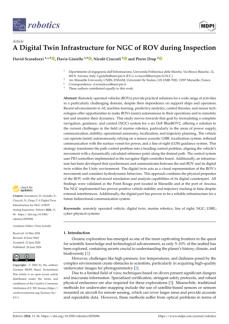Studies of ROV concepts 2024 - Part A



Authors:
Guangyuan Liu, Nguyen Van Huynh, Hongyang Du,
Dinh Thai Hoang, Dusit Niyato, Kun Zhu, Jiawen Kang,
Zehui Xiong, Abbas Jamalipour, and Dong In Kim
Advances in AI and robotics have increased interest in
swarms of unmanned vehicles for tasks that are too risky
for humans.
However, managing and coordinating these swarms in
dynamic settings poses significant challenges for
traditional AI methods. Generative AI (GAI) could be a
game-changer here, given its ability to handle complex
data. This paper surveys the applications, challenges, and
opportunities of GAI in unmanned vehicle swarms.

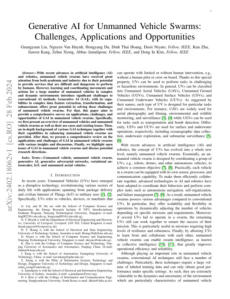

Authors:
Aryan Anand, M. Yuva Bharath, Prabha Sundaravadivel, J.
Preetha Roselyn, and R. Annie Uthra
This study introduces and describes a new approach to
underwater exploration that integrates Artificial
Intelligence (AI) with Autonomous Underwater Vehicles
(AUVs). It highlights the benefits of combining AI with
biomimicry to enhance the capabilities of AUVs, enabling
them to emulate the efficient and graceful movements of
marine creatures. The text outlines the development of a
new propulsion system inspired by marine organisms,
specifically cuttlefish, and discusses the advantages of this
system in terms of energy efficiency and reduced
environmental impact.

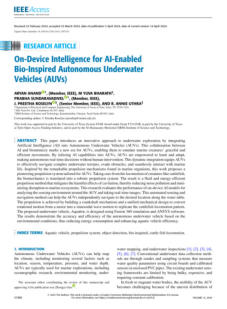

Authors: Fomekong Fomekong Rachel Merveille, Baozhu
Jia,and Zhizun Xu
This presentation discusses advancements in underwater
navigation for Unmanned Underwater Vehicles (UUVs) by
integrating deep learning methodologies and sensor
technologies. It highlights the challenges faced by
traditional navigation methods due to signal loss in water
and proposes the use of artificial intelligence, specifically
deep learning and visual Simultaneous Localization and
Mapping (SLAM), to enhance navigation accuracy and
reliability. The authors also provide detailed insights into
various sensor technologies and their applications in
underwater navigation.

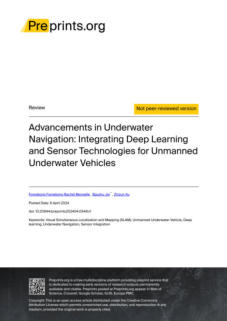

Author: Changho Yun
This paper advocates for the Underwater Multi-channel
Medium Access Control with Cognitive Acoustics
(UMMAC-CA) as an effective channel access protocol for
distributed underwater cognitive acoustic networks
(UCANs) by explaining the advantages of UMMAC-CA,
such as improved spectral efficiency, reduced channel
access overhead, and better performance metrics
compared to the existing Multi-channel Medium Access
Control with Cognitive Radios (MMAC-CR).

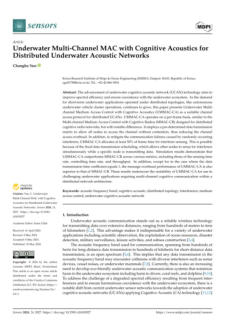

Author: Wenwei Zhang, Kun Zhu, Zhichun Yang, Yunling
Ye, Junfeng Ding, and Jin Gan
This study addresses the challenges of detecting
underwater damage to structures with pile foundations. It
introduces the design and evaluation of an adsorption-
operated robotic system equipped with an automatic
movement mechanism and a force-redeemed active
disturbance rejection controller. Additionally, it develops a
new detection algorithm based on the image
segmentation network UNet.



Author: Angelo Mari C. Paredes, & Edwin R. Arboleda
This study analyzes the challenges and advancements in
underwater communication for Underwater Wireless
Sensor Networks (UWSNs) by highlighting the difficulties
posed by the underwater environment, such as
attenuation, multipath propagation, and limited
bandwidth, and discusses how innovative antenna
designs can address these issues. It examines different
types of antennas (monopole, dipole, and helical), their
trade-offs, and advancements in materials and
reconfigurable antennas that offer promising solutions.

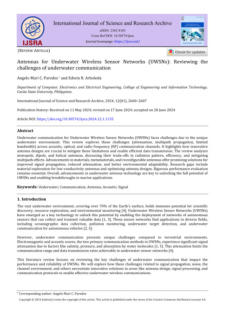

Authors:
Shuangquan Li, Zhichen Zhang, Qixian Zhang, Haiyang
Yao, Xudong Li, Jianjun Mi, & Haiyan Wang
This document reviews and analyzes recent
advancements in underwater optics, particularly focusing
on the challenges and developments in underwater
optical transmission. It highlights the importance of
understanding underwater optical laws and physical
models and their applications in various domains, such as
underwater resource exploration, autonomous
underwater vehicle navigation, and underwater wireless
optical communication. It also identifies future directions
and emphasizes the need for further research to enhance
underwater optical technologies and their applications.

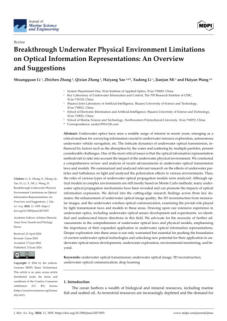


Click on the
octopus to return to
the top of the page

Authors: Pei Li, Zongyao Li, Chaoyang Chen, Juan Chen,
and Zuguo Chen
This article explains a novel method for improving the
positioning accuracy of autonomous underwater vehicles
(AUVs) by addressing communication delays, describing
how it uses relative angle correction and Doppler
measurement data integrated into an Extended Kalman
Filter (EKF) to reconstruct measurement information and
reduce positioning errors. The effectiveness of this method
is demonstrated through a simulation study, showing
significant improvements in localization accuracy.

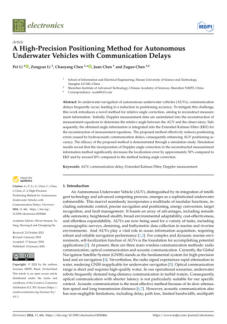

Authors: Jia Wang, Tianyi Tao, Daohua Lu, Zhibin Wang,
and Rongtao Wang
This document presents a new algorithm designed to
enhance the efficiency of Autonomous Underwater
Vehicles (AUVs) by addressing task allocation and path
planning challenges to highlight the limitations of current
AUV energy usage and deployment methods, introduce
the proposed algorithm, and demonstrate its effectiveness
through simulation and comparative experiments. The
system's ultimate goal is to improve the operational
efficiency of heterogeneous AUV clusters by optimizing
task execution and energy management.

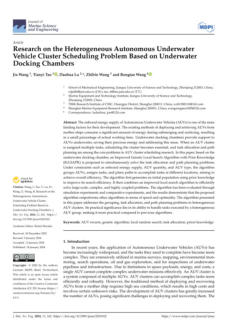

Authors: Liwei Zhi and Yi Zuo
This proposal addresses the path planning problem for
multiple Autonomous Underwater Vehicles (AUVs) using
a novel method called adaptive multi-population particle
swarm optimization (AMP-PSO). It explains the
methodology implemented, including the grouping
strategy and exchanging mechanism of particles, and
highlights the effectiveness of AMP-PSO through
simulation results.




Authors: Jimin Hwang, Neil Bose, Gina Millar, Craig
Bulger, Ginelle Nazareth, and Xi Chen
This paper describes the objectives, methodology, and
results of a research study focused on testing an adaptive
sampling method for an autonomous underwater vehicle
(AUV) to track a hydrocarbon plume in the water column
and validate the system through field trials. It outlines the
components of the system, the testing process, and the
successful outcomes, emphasizing the system's resilience
and applicability in marine pollutant assessment and
mitigation.

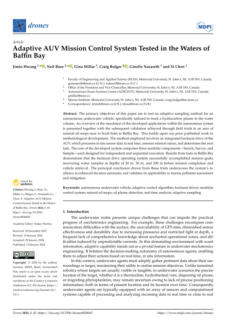

Authors: Lin Zhang, Yanbin Gao, and Lianwu Guan
This paper highlights the limitations of traditional
navigation systems like strapdown inertial navigation
systems (SINS) and Doppler velocity logs (DVL) due to
positioning errors and susceptibility to failure in complex
underwater conditions. It proposes an integrated
navigation approach using factor graph optimization
(FGO) and an improved pre-integration technique that
incorporates side-scan sonar (SSS) derived position
measurements to demonstrate how this new method
improves the reliability and accuracy of navigation in
AUVs, particularly in challenging environments, and to
share the positive results from marine experiments.

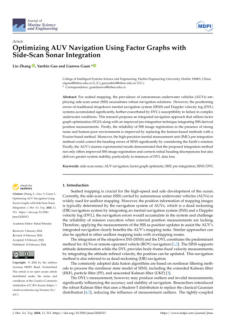

Authors: Zheping Yan, Mingyao Zhang, Jiajia Zhou and
Lidong Yue
This paper introduces a novel control approach, the
Distributed Lyapunov-based Model Predictive Controller
(DLMPC) with a Fast Finite-Time Extended State Observer
(FFTESO), to enhance the performance of AUVs by
compensating for external disturbances and internal
uncertainties. It explains the methodology implemented,
including developing position and velocity tracking
controllers, managing system constraints, and applying a
Lyapunov-based backstepping control law to ensure
stability. It also highlights the effectiveness of the proposed
method through simulation results, demonstrating
improved convergence speed and tracking accuracy.

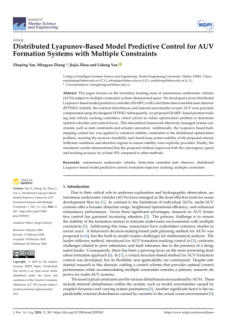

Authors: Jacek Zalewski, and Stanisław Hozyn
This document highlights the current problem of
inadequate navigation in AUVs due to weaknesses in
electronic equipment and the limitations of traditional
radio navigation systems. It introduces a novel approach
that involves generating a visual representation of the
vehicle's surroundings during temporary surfacing and
comparing it with a map's shoreline representation to
enhance positioning accuracy. The method is particularly
aimed at low-cost AUVs lacking advanced navigation
systems, and the text suggests that further research will
explore its application in fully autonomous navigation
systems.

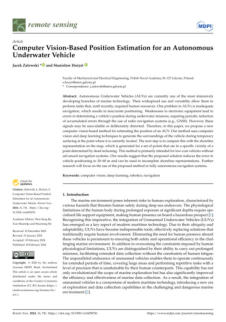

Authors: Kene Li, Liuying Li, Chunyi Tang, Wanning Lu,
and Xiangsuo Fan
This paper outlines a six-direction search scheme based on
neural networks, detailing how it constructs obstacle
energy and path energy to optimize path planning. It also
discusses two optimization methods to improve the
efficiency of the search algorithm, aiming to reduce
iterations and search time. It concludes by stating that
simulation results validate the effectiveness and efficiency
of the proposed scheme.

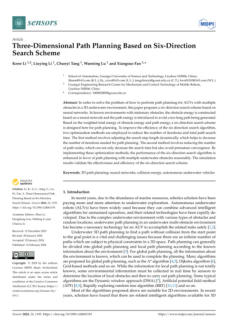

Author: Shuo Pang, Ye Li, Liang Xiao, Francisco Rego, and
Teng Ma
This paper aims to showcase the benefits and future
implications of using unmanned surface and underwater
vehicles in extreme environments for monitoring and
safeguarding ocean resources. It summarizes key research
papers that address challenges and innovations in areas
such as sensing, control, navigation, and communication
of these vehicles, providing insights into their operation
and potential for enhancing oceanographic data
collection.

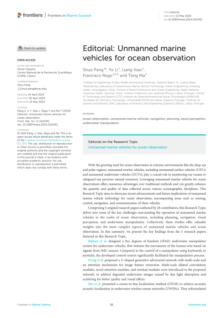

Author:
Hong Zhu, Lunyang Lin, Chunliang Yu, Yuxiang Chen ,
Hong Xiong, Yiyang Xing, and Guodong Zheng
This paper presents a study focusing on enhancing the
maneuverability of autonomous underwater vehicles
(AUVs) through the development of a novel vectored
thruster and optimized blade design, detailing the design
specifications, testing, and performance evaluation of the
thruster and highlighting its effectiveness in improving
AUV control and efficiency in both controlled and
offshore environments.

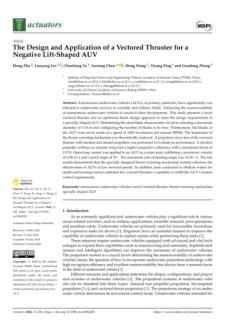

Author:
Pinchi Li, Xiaona Sun, Ziyun Chen, Xiaolin Zhang,
Tianhong Yan, and Bo He
This study addresses the challenges posed by outliers and
non-Gaussian noise in underwater environments, which
can affect the performance of navigation algorithms. The
proposed solution combines the Maximum Correntropy
Criterion (MCC) with the Variational Bayesian approach to
enhance robustness and adaptability. It details the
methodology, including using an Unscented Kalman Filter
(UKF) and evaluating the algorithm's performance
through simulations and sea trials, highlighting significant
improvements in navigation accuracy.

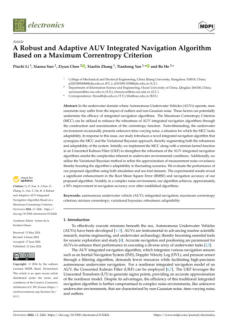

Author:
Huibao Yang, Xiujing Gao, Bangshuai Li, Bo Xiao, and
Hongwu Huang
This article describes the development and optimization of
the Chan-Taylor algorithm, specifically introducing the
Weighted Modified Chan-Taylor (WMChan-Taylor)
algorithm and an error-corrected version of it. It also
explains how these algorithms improve positioning
accuracy by correcting noise variance and isolating noisier
stations, supported by computer and semi-physical
simulation experiments.



Author: Yufei Xu, Ziyang Zhang, and Lei Wan
This study focuses on developing a control method for
benthic autonomous underwater vehicles (AUVs) that
addresses challenges related to model uncertainties and
external disturbances. It introduces a robust prescribed-
time extended state observer (RPTESO) and a non-singular
robust practical predefined-time sliding mode control
(RPPSMC) to enhance control accuracy and robustness. It
also conveys these methods' design, implementation, and
effectiveness through theoretical analysis and simulations.

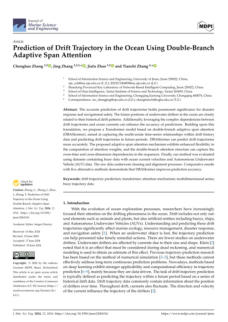

Author:
Chenghao Zhang, Jing Zhang, Jiafu Zhao, and Tianchi
Zhang
This study highlights the importance of accurate drift
trajectory predictions for disaster response and
navigational safety and explains how the proposed model
leverages historical drift patterns and ocean currents to
enhance prediction accuracy. It also details the model's
features, such as the double-branch adaptive span
attention mechanism, and présents evaluation results
showing its improved performance compared to other
methods.

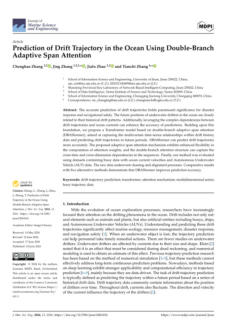

Author:
Huanyu Ou, Yuli Hu, Zhaoyong Mao, Wenlong Tian, and
Bo Cheng
This study proposes a cooling improvement method using
heat bridges (HBs) for the shell-mounted propulsion
motor (SmPM) and details the analysis, development,
testing, and optimization of this method. The presentation
aims to convey the effectiveness of the proposed cooling
solution in reducing the motor's maximum winding
temperature and weight, thereby enhancing the motor's
reliability and stability.

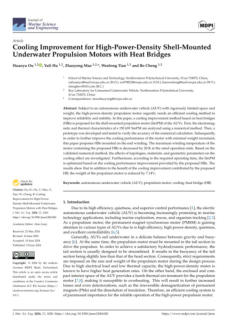

Author:
Zhuoyu Zhang, Wangjie Ding, Rundong Wu, Mingwei
Lin, Dejun Li, and Ri Lin
This paper introduces a vision guidance algorithm and a
fusion positioning algorithm to enhance accuracy and
effectiveness in these operations, supported by simulation
results and experimental validation.

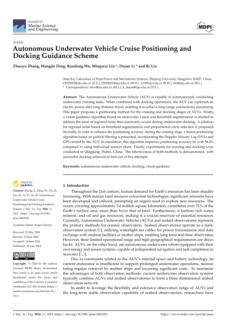

Author: Raqibur Rahman
This paper details the training and testing of different
depth prediction models and poses prediction models
using different datasets and input spaces. It also discusses
the use of these predicted depths in underwater image
enhancement and RGB-D SLAM pipelines to demonstrate
that techniques originally developed for airborne vision
can be adapted to underwater environments where
traditional depth sensing methods are challenging.

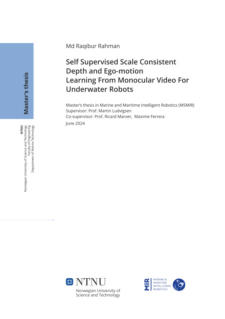

Author: Changho Yun, and Yong-Ju Kwon
This document presents a study on the challenges and
solutions related to handover mechanisms in base-station-
based underwater wireless acoustic networks (B-UWANs),
focusing on how the motion of moored buoy base
stations, influenced by environmental conditions, affects
handover decision errors for mobile nodes like
autonomous underwater vehicles (AUVs). It analyzes
these errors and proposes an analytical framework to
improve handover protocols, thereby enhancing the
reliability and continuity of data services in such networks.

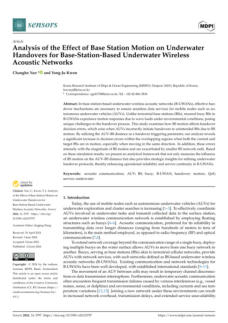

Author: Jieen Yao, Junzheng Yang, Chenghao Zhang,
Jing Zhang, and Tianchi Zhang
This paper highlights the limitations of existing methods
and presents the proposed model, NKOA-BiLSTM-TVA, as
a solution that incorporates various advanced techniques
such as opposition-based learning, a nonlinear Kepler
optimization algorithm, and a time-variable attention
mechanism. The intent is to demonstrate the effectiveness
and accuracy of this model in predicting AUV trajectories,
as well as its applicability to ship trajectory prediction.

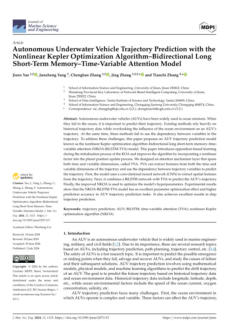









1 - Obstacles Detection in Underwater Environment Using ROV
Based on Convolutional Neural Network
Authors: Purwidi Asri, Yuning Widiarti, Endang Pudji
Purwanti, Endah Wismawati, M. Firman Tsany
Arifin
Detecting obstacles underwater is hard for Remotely
Operated Vehicles (ROVs) due to limited visibility. This
study develops a better detection system using a
Convolutional Neural Network (CNN). It aims to help
ROVs avoid obstacles during missions like ship inspections
and marine exploration. The system uses an underwater
camera and CNN-based image processing, trained on
various underwater images, achieving 99. 25% validation
accuracy and 85% real-time classification accuracy. This
method improves ROV reliability for marine applications.
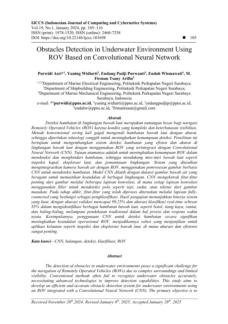



11 - Implementation of miniaturized power transmission system of
ROV
Authors: Mingyu Yang, Shiyu Zhao, Yixuan Tong and
Guangyu Lu
The power transmission system is essential for ROVs to
operate underwater securely. A new method using matrix
transformation reduces transmission loss and current. By
increasing transmission frequency at the underwater end,
transformer size is minimized, enhancing efficiency for
high-power ROV applications.
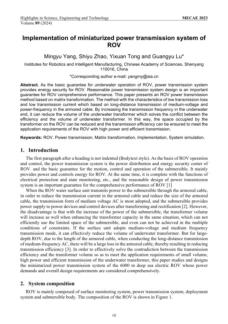



12 - Numerical simulation of hydrodynamics of ocean-observation-
used remotely operated vehicle.
Authors: Dapeng Zhang, Bowen Zhao, Yi Zhang, and
Nan Zhou
Remotely operated vehicles (ROVs) are the most common
underwater robots, excelling in complex environments.
Hydrodynamic coefficients are crucial for predicting ROV
performance. The motion model is established, simulated
with specific methods, and results showed significant
pressure resistance differences based on movement
direction and speed, confirming simulation accuracy for
design guidance.
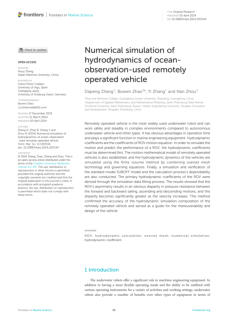



15 - Multi-AUV Based Underwater Target Tracking Method via
Reinforcement Learning in Dynamic Ocean Environment.
Authors: Tianxiang Xing, Jingzehua Xu, Jun Du,
Xiangwang Hou, Tianyu Xing, Yong Ren
Autonomous underwater vehicles (AUVs) are valuable for
underwater tasks, but a single AUV has limited abilities. A
multi-AUV system is used for complex tasks like target
tracking, but existing studies don't reflect real ocean
conditions. This paper presents a multi-AUV tracking
method using reinforcement learning in dynamic
environments. It involves modeling ocean currents and
applying a Markov decision process for navigation.
Simulation results show an 83% success rate, indicating
improved tracking accuracy and robustness.
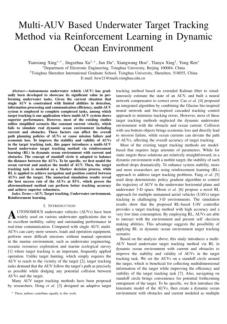



16 - Embracing the future: the rise of humanoid robots and
embodied AI
Authors: Jiankun Wang, Chaoqun Wang, Weinan Chen,
Qi Dou, Wenzheng Chi
In an era of fast technological progress, humanoid robots
and embodied artificial intelligence (AI) are advancing
machine capabilities. These robots, designed to look and
behave like humans, can transform sectors like healthcare
and industry. They perform tasks efficiently, assist
individuals with disabilities, offer companionship, and aid
in therapy. These technologies combine AI with physical
forms and address significant societal challenges.




19 - Ego-to-Exo: Interfacing Third Person Visuals from Egocentric
Views in Real-time for Improved ROV Teleoperation.
Authors: Adnan Abdullah, Ruo Chen, Ioannis Rekleitis,
and Md Jahidul Islam
IUnderwater ROVs are unmanned vehicles for ocean
exploration. This paper introduces a new teleoperation
interface that provides third-person visuals and real-time
ROV position information. It uses a 3D geometry
algorithm with monocular Simultaneous Localization and
Mapping (SLAM) for accurate navigation. The method has
been validated through experiments in low-light
conditions, showing benefits for remote operation. This
interactive approach offers new research opportunities in
underwater telerobotics.
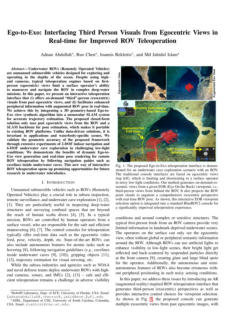



20 - Parameter identification of an open-frame underwater vehicle
based on numerical simulation and quantum particle swarm
optimization.

Authors: Mingzhi Chen, Yuan Liu, Daqi Zhu, Anfeng
Shen, Chao Wang, Kaimin
Accurate parameter identification of underwater vehicles
is important for controller design and fault diagnosis.
Some research uses numerical simulations to find model
parameters but often only perform single-degree-of-
freedom steady-state simulations. This paper solves the
velocity response of underwater vehicles using the
overset grid and Dynamic Fluid-Body Interaction model. It
introduces a quantum particle swarm optimization
method to identify inertia and resistance parameters. The
identified model's mean square error of forward velocity is
less than 0. 20%, outperforming other methods.
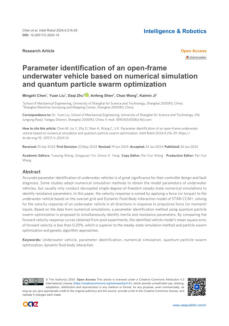



33 - Solar-Powered ROV: Advancing Underwater Exploration with
Renewable Energy

Authors: Sani Mohammed Lawal, Shima Valizadeh,
Nazila Fough, Somasundar Kannan
This paper presents a solar-powered solution for remotely
operated vehicles (ROVs) used in underwater inspections
and exploration. The Blue ROV can operate for 5 hours
with solar power, supported by a miniaturized 10Hp/12kg
design with an energy demand of 943.68W. Solar panels
on floating platforms provide the necessary power, with
detailed calculations for optimal panel size and number.
The system includes inverters, charge controllers, and
battery banks for continuous operation, promoting
sustainable maritime activities.




34 - A Digital Twin Infrastructure for NGC of ROV during Inspection
Authors: David Scaradozzi, Flavia Gioiello, Nicolò
Ciuccoli, and Pierre Drap
Remotely operated vehicles (ROVs) can perform many
tasks, though they need support ships and operators.
Recent tech advancements aim to make ROVs semi-
autonomous. This study presents a navigation, guidance,
and control (NGC) system for the BlueROV2, solving
challenges in power, communication, and stability. It uses
a sensor system for localization, tethered communication
for power, and a heading control strategy. A digital twin
has been created for simulation and analysis, validated at
ports in Marseille and Ancona. The NGC system showed
improved stability and trajectory tracking, supporting
future communication systems.
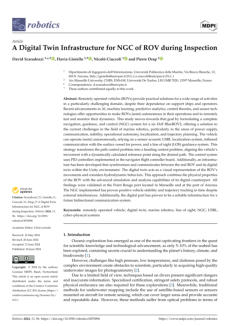



35 - Artificial Neural Network for Glider Detection in a Marine
Environment by Improving a CNN Vision Encoder
Authors: Jungwoo Lee, Ji-Hyun Park, Jeong-Hwan
Hwang, Kyoungseok Noh, , Youngho Choi, and
Jinho Suh
Much of the ocean is still unexplored, leading to the use
of remotely operated vehicles (ROVs) and gliders for data
collection. A safer and more efficient system for recovering
gliders is needed. This study proposes a lightweight
artificial neural network for detecting underwater gliders.
The model achieved an average precision (AP) of 99.7%,
outperforming the existing EfficientDet-D2 model, which
had an AP of 69.2%. The results indicate high accuracy in
glider detection.
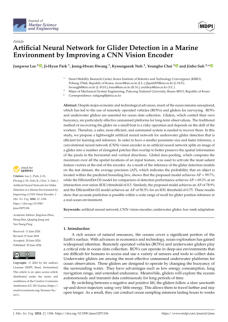



36 - A Digital Twin Infrastructure for NGC of ROV during Inspection
Authors: David Scaradozzi, Flavia Gioiello, Nicolo Ciuccoli,
and Pierre Drap
This study presents a navigation, guidance, and control
(NGC) system for a six DoF BlueROV2, aiming to make
ROVs semi-autonomous and remotely test their dynamics.
The system uses a sensor acoustic USBL localization
system, tethered communication with the surface vessel
for power, and a line of sight guidance system. The
control system uses PID controllers and a digital twin to
visualize the ROV's movements and hydrodynamic
behaviors. The system has proven positive vehicle stability
and trajectory tracking, and has the potential for a future
bidirectional communication system.
